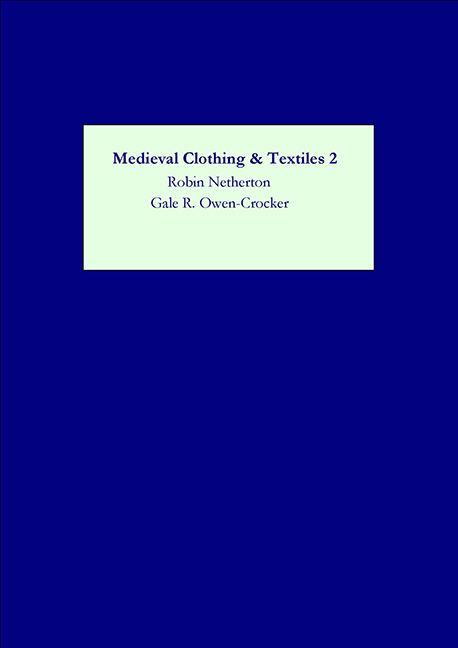Book contents
- Frontmatter
- Contents
- Illustrations page
- Tables
- Contributors
- Preface
- 1 Dress and Accessories in the Early Irish Tale 'The Wooing Of Becfhola”
- 2 The Embroidered Word: Text in the Bayeux Tapestry
- 3 “De Fil d'Or et de Soie”: Making Textiles in Twelfth-Century French Romance
- 4 Biffes, Tiretaines, and Aumonières: The Role of Paris in the International Textile Markets of the Thirteenth and Fourteenth Centuries
- 5 'Clothing Themselves in Acres”: Apparel and Impoverishment in Medieval and Early Modern England
- 6 'Ye Shall Have It Cleane”: Textile Cleaning Techniques in Renaissance Europe
- 7 Fleas, Fur, and Fashion: Zibellini as Luxury Accessories of the Renaissance
- 8 The Matron Goes to the Masque: The Dual Identity of the English Embroidered Jacket
- Recent Books of Interest
- Index
2 - The Embroidered Word: Text in the Bayeux Tapestry
Published online by Cambridge University Press: 14 February 2019
- Frontmatter
- Contents
- Illustrations page
- Tables
- Contributors
- Preface
- 1 Dress and Accessories in the Early Irish Tale 'The Wooing Of Becfhola”
- 2 The Embroidered Word: Text in the Bayeux Tapestry
- 3 “De Fil d'Or et de Soie”: Making Textiles in Twelfth-Century French Romance
- 4 Biffes, Tiretaines, and Aumonières: The Role of Paris in the International Textile Markets of the Thirteenth and Fourteenth Centuries
- 5 'Clothing Themselves in Acres”: Apparel and Impoverishment in Medieval and Early Modern England
- 6 'Ye Shall Have It Cleane”: Textile Cleaning Techniques in Renaissance Europe
- 7 Fleas, Fur, and Fashion: Zibellini as Luxury Accessories of the Renaissance
- 8 The Matron Goes to the Masque: The Dual Identity of the English Embroidered Jacket
- Recent Books of Interest
- Index
Summary
The Bayeux Tapestry, at 68.38 metres long (224 feet 4 inches), is the largest surviving medieval textile. This embroidered narrative frieze, almost certainly designed in Canterbury, England, and generally believed to have been made there, was probably
A shorter version of this article, “The Scene and the Unseen: Text in the Bayeux Tapestry,” was presented as a paper in May 2005 at the International Congress on Medieval Studies at Kalamazoo, Michigan. I am grateful for advice given on that occasion by members of the audience, particularly George Brown, Elizabeth Coatsworth, and Jacqueline Stodnick, and also for guidance on manuscript punctuation by my colleague Alexander Rumble.
commissioned for Odo, bishop of Bayeux, the half-brother of Duke William of Normandy, between 1066 and the 1080s. Its pictorial record of events leading up to the Norman Conquest of England is accompanied by an explanatory inscription, mostly taking the form of tituli (surtexts along the top of the main register), comprising 2,226 characters and symbols, the longest known text of its kind. The inscription is transcribed and translated in table 2.1, with an approximation of the spacing and punctuation; uncial letters are there represented with a mixture of lower case and Greek letters. Punctuation and uncials are not represented in quotations in the body of this article for typographical reasons.
THE TEXT: LETTERING, SPELLING, LANGUAGE
The majority of the inscription's letters are square capitals, with a scattering of uncial forms. There appears to be no consistency in the use of the uncials: though the frieze is made out of nine pieces of linen, some of which were evidently worked in separate locations, the distribution of the lettering does not give any clear indication that different scribes wrote the separate sections. Neither is there any pattern in the variant spellings of recurrent names—Edward, William, and Wido (Guy of Pontieu).
The language of the text is Latin. Other near-contemporary textile inscriptions are also Latin, but this choice of language for the Bayeux Tapestry is interesting since the work is not biblical and does not have overtly religious subject matter, though it includes two churches, two priests, and a bishop, and, arguably, a moral message. Its materials are linen and wool, not the silk and spun gold of ecclesiastical vestments and other luxury textiles with inscriptions.
- Type
- Chapter
- Information
- Medieval Clothing and Textiles 2 , pp. 35 - 60Publisher: Boydell & BrewerPrint publication year: 2006



